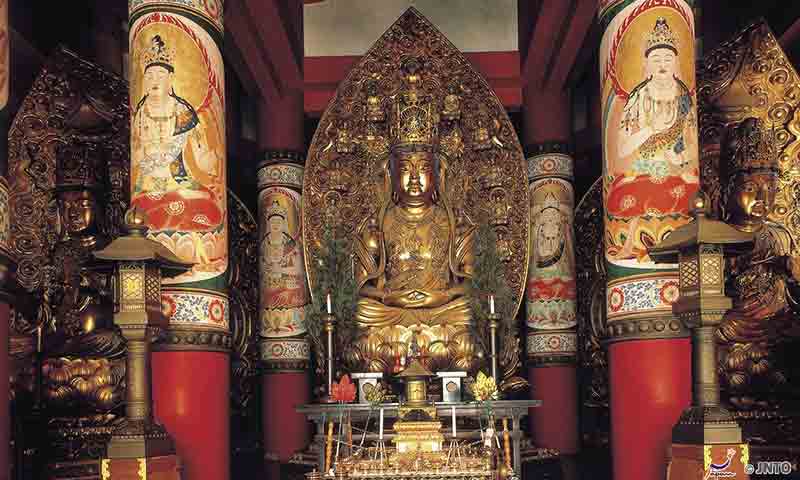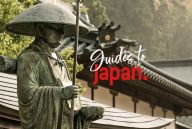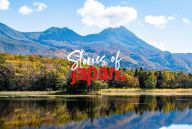When many people imagine a trip to Japan, the mind turns to high-paced, modern city life. However, just an hour or two away from some of the country’s most vibrant urban centres lies an altogether different kind of experience, one that focuses on cleansing and rejuvenating the soul by offering an insight into the ancient practices of one of Japan’s major religion, Shingon Buddhism.

High up in the Kii mountains, surrounded by thick cedar forests in the lush Koya-Ryujin Quasi-National Park, lies one of Japan’s most sacred sites: Koyasan, a UNESCO World Heritage Site and the birthplace of Shingon Buddhism. Once home to more than 2000 temples, today Koyasan’s monastery complex has 117 working temples, with 52 of them ready to welcome visitors in search of a deeply relaxing and reflective retreat.
Temple stays are the perfect way for visitors to both observe and participate in a uniquely Japanese way of life, offering a glimpse into the inner workings of Shingon Buddhism and a true respite from the stresses of the modern world.
A temple stay, or shukubo, invites guests to take part in the monks’ daily rituals, immersing themselves in the tranquillity of a culture that values peacefulness and harmony. This is most clearly experienced through the sharing of the monk’s traditional vegetarian cuisine, the ancient art of calligraphy writing, meditation and the traditional morning Buddhist services, all set among the beautiful gardens and secluded temple town of Koyasan
Shojin-ryori

Balance and subtly are the words that most easily describe the region’s unique shojin-ryori cuisine. Prepared exclusively with incredibly fresh local, seasonal produce, shojin-ryori not only shuns meat and fish, but also vegetables such as garlic, onions and other pungent ingredients in search of a perfect harmony of flavours. Specialties include Koya dofu (freeze dried tofu) and its sesame-flavoured relative, goma dofu (sesame tofu).
This delicate, beautifully balanced and subtle collection of flavours is thought to rejuvenate the body and mind, and fits perfectly with the sights and sounds of a Shingon temple stay.
Sutra copying

Calligraphy writing has been admired in Japan for generations, and sutra copying is considered one of the purest ways to practice this ancient skill. This Buddhist practice involves the hand copying of Buddhist texts and requires peace and concentration to create beautiful Japanese calligraphy (called shodo).
The art of sutra copying is considered to be an expression of devotion. It is thought that all those who intently hand-copy the sutra will become healthy in both mind and body
Meditation

Some of Koyasan’s temples are able to offer guests the chance to practice a traditional type of meditation called ajikan.
Ajikan is a Shingon form of meditation that centres on the sound, form, and meaning of the Sanskrit syllable “A”. Surrounded by the serenity of the Kii mountains and forests, this focuses on breathing exercises to help still the mind, offering visitors a true insight into the practices of Shingon Buddhism.
Monks are on hand to help teach and guide beginners. Only some shukubo temples are able to provide an ajikan experience to private visitors, so be sure to check first
Morning Buddhist services

Buddhist monks begin every day reciting scriptures and prayers in the early morning light. During the ceremony, the chief priest and monks of the temple chant Buddhist sutras.
Overnight guests of shukubo temples can observe or participate in these early morning prayers in the temple hall. Being involved with this group practice, in the peaceful surroundings of Koyasan, can be a moving and deeply spiritual experience.
Even a short stay in one of Koyasan’s shukubo temples will provide guests with a deeper appreciation of this unique aspect of Japanese life.
The monks of shukubo temples, quite accustomed to welcoming international visitors, do request that guests adhere to their philosophy and practices during their stay. In exchange, overnight guests can expect traditional and often modest Japanese rooms with tatami floors and sliding doors, with a futon bed that is rolled away during the day, exactly as the monks have done for centuries. Times for sleeping, dining and meditating are often fixed, offering guests a true reflection of life as a Buddhist monk.
Some shukubo temples have started to accept credit cards (but some still do not) and cost between $100 and $200 a night including traditional vegetarian Buddhist shojin-ryori breakfast and dinner. Some of the temples serve alcoholic beverages.
Picturesque Koyasan is most easily reached by train from either Osaka (one and half hours away) or Kyoto (two hours away). Once there, the pace of life slows down. Designated as a UNESCO World Heritage site in 2004, the “Sacred Sites and Pilgrimage Routes in the Kii Mountain Range” area has various paths that are collectively known as the Kumano Kodo.
For more than ten centuries, people have journeyed to the tranquil Kii Mountains following many pilgrimage routes to Koyasan temples and shrines. Seven routes connect the complex of Buddhist temples and three main Shinto Grand Shrines in the area.
For more information on temple lodging in Koyasan, or to book a temple stay, visit the Koyasan Shukubo Association, eng.shukubo.net. The Visit Japan AU Facebook and @VisitJapanAU Instagram account will also help inspire visitors and offer tips on travelling in Japan.



















































